Behavior and Failure Mechanism of Modern and Ancient Arches
VerifiedAdded on 2023/06/04
|11
|2810
|338
AI Summary
This article discusses the behavior and failure mechanism of modern and ancient arches. It covers the types of arches, their behavior under load, failure modes, and examples of modern and ancient arches.
Contribute Materials
Your contribution can guide someone’s learning journey. Share your
documents today.
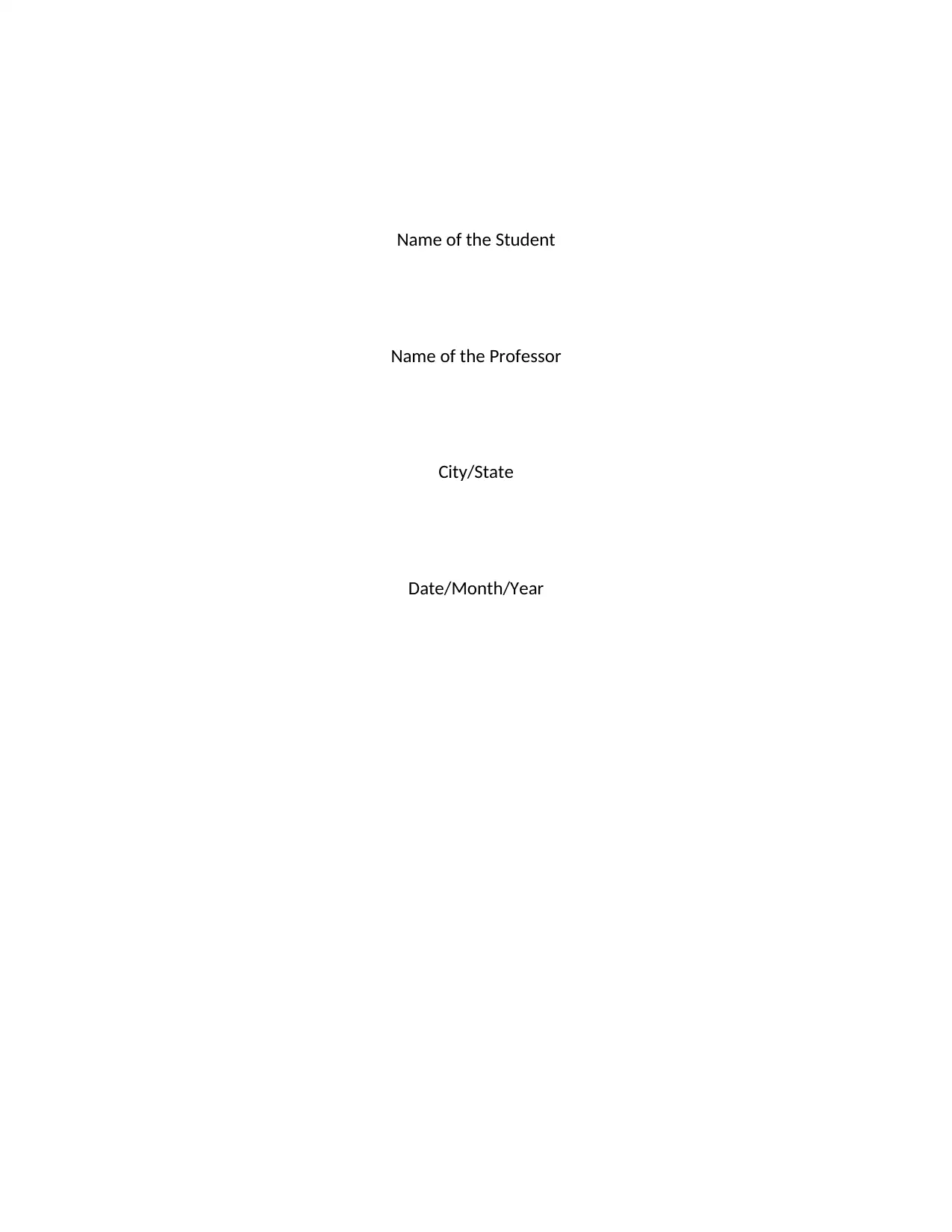
Name of the Student
Name of the Professor
City/State
Date/Month/Year
Name of the Professor
City/State
Date/Month/Year
Secure Best Marks with AI Grader
Need help grading? Try our AI Grader for instant feedback on your assignments.
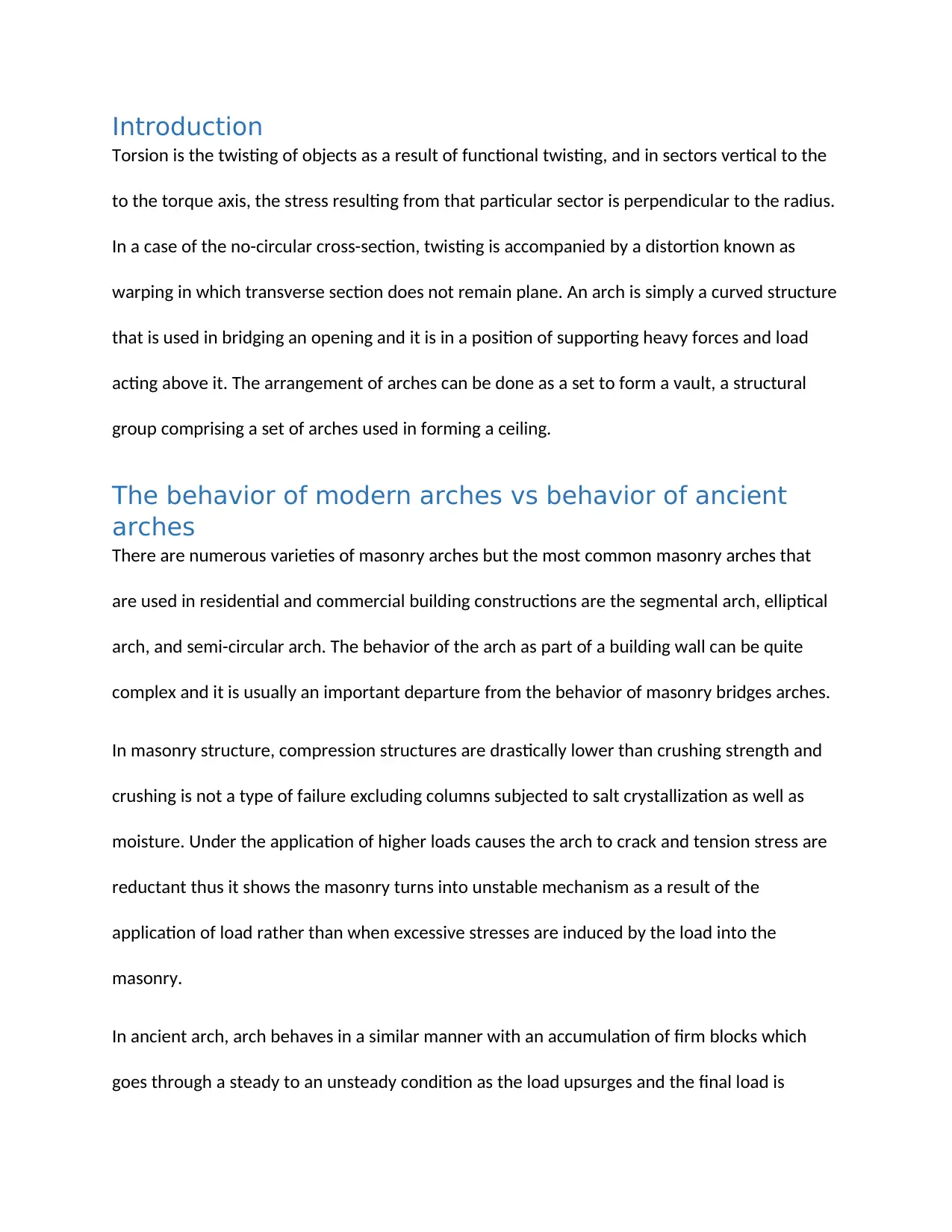
Introduction
Torsion is the twisting of objects as a result of functional twisting, and in sectors vertical to the
to the torque axis, the stress resulting from that particular sector is perpendicular to the radius.
In a case of the no-circular cross-section, twisting is accompanied by a distortion known as
warping in which transverse section does not remain plane. An arch is simply a curved structure
that is used in bridging an opening and it is in a position of supporting heavy forces and load
acting above it. The arrangement of arches can be done as a set to form a vault, a structural
group comprising a set of arches used in forming a ceiling.
The behavior of modern arches vs behavior of ancient
arches
There are numerous varieties of masonry arches but the most common masonry arches that
are used in residential and commercial building constructions are the segmental arch, elliptical
arch, and semi-circular arch. The behavior of the arch as part of a building wall can be quite
complex and it is usually an important departure from the behavior of masonry bridges arches.
In masonry structure, compression structures are drastically lower than crushing strength and
crushing is not a type of failure excluding columns subjected to salt crystallization as well as
moisture. Under the application of higher loads causes the arch to crack and tension stress are
reductant thus it shows the masonry turns into unstable mechanism as a result of the
application of load rather than when excessive stresses are induced by the load into the
masonry.
In ancient arch, arch behaves in a similar manner with an accumulation of firm blocks which
goes through a steady to an unsteady condition as the load upsurges and the final load is
Torsion is the twisting of objects as a result of functional twisting, and in sectors vertical to the
to the torque axis, the stress resulting from that particular sector is perpendicular to the radius.
In a case of the no-circular cross-section, twisting is accompanied by a distortion known as
warping in which transverse section does not remain plane. An arch is simply a curved structure
that is used in bridging an opening and it is in a position of supporting heavy forces and load
acting above it. The arrangement of arches can be done as a set to form a vault, a structural
group comprising a set of arches used in forming a ceiling.
The behavior of modern arches vs behavior of ancient
arches
There are numerous varieties of masonry arches but the most common masonry arches that
are used in residential and commercial building constructions are the segmental arch, elliptical
arch, and semi-circular arch. The behavior of the arch as part of a building wall can be quite
complex and it is usually an important departure from the behavior of masonry bridges arches.
In masonry structure, compression structures are drastically lower than crushing strength and
crushing is not a type of failure excluding columns subjected to salt crystallization as well as
moisture. Under the application of higher loads causes the arch to crack and tension stress are
reductant thus it shows the masonry turns into unstable mechanism as a result of the
application of load rather than when excessive stresses are induced by the load into the
masonry.
In ancient arch, arch behaves in a similar manner with an accumulation of firm blocks which
goes through a steady to an unsteady condition as the load upsurges and the final load is
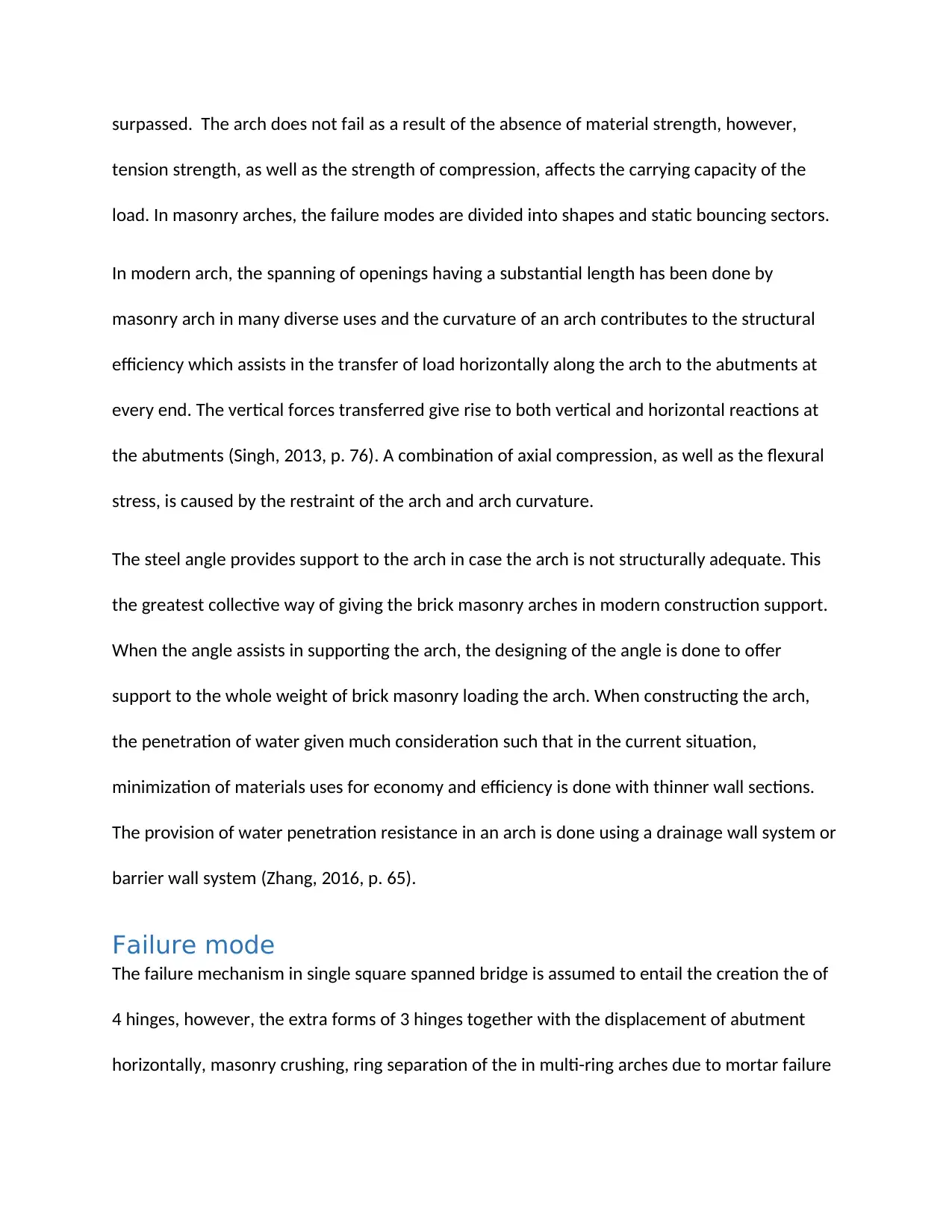
surpassed. The arch does not fail as a result of the absence of material strength, however,
tension strength, as well as the strength of compression, affects the carrying capacity of the
load. In masonry arches, the failure modes are divided into shapes and static bouncing sectors.
In modern arch, the spanning of openings having a substantial length has been done by
masonry arch in many diverse uses and the curvature of an arch contributes to the structural
efficiency which assists in the transfer of load horizontally along the arch to the abutments at
every end. The vertical forces transferred give rise to both vertical and horizontal reactions at
the abutments (Singh, 2013, p. 76). A combination of axial compression, as well as the flexural
stress, is caused by the restraint of the arch and arch curvature.
The steel angle provides support to the arch in case the arch is not structurally adequate. This
the greatest collective way of giving the brick masonry arches in modern construction support.
When the angle assists in supporting the arch, the designing of the angle is done to offer
support to the whole weight of brick masonry loading the arch. When constructing the arch,
the penetration of water given much consideration such that in the current situation,
minimization of materials uses for economy and efficiency is done with thinner wall sections.
The provision of water penetration resistance in an arch is done using a drainage wall system or
barrier wall system (Zhang, 2016, p. 65).
Failure mode
The failure mechanism in single square spanned bridge is assumed to entail the creation the of
4 hinges, however, the extra forms of 3 hinges together with the displacement of abutment
horizontally, masonry crushing, ring separation of the in multi-ring arches due to mortar failure
tension strength, as well as the strength of compression, affects the carrying capacity of the
load. In masonry arches, the failure modes are divided into shapes and static bouncing sectors.
In modern arch, the spanning of openings having a substantial length has been done by
masonry arch in many diverse uses and the curvature of an arch contributes to the structural
efficiency which assists in the transfer of load horizontally along the arch to the abutments at
every end. The vertical forces transferred give rise to both vertical and horizontal reactions at
the abutments (Singh, 2013, p. 76). A combination of axial compression, as well as the flexural
stress, is caused by the restraint of the arch and arch curvature.
The steel angle provides support to the arch in case the arch is not structurally adequate. This
the greatest collective way of giving the brick masonry arches in modern construction support.
When the angle assists in supporting the arch, the designing of the angle is done to offer
support to the whole weight of brick masonry loading the arch. When constructing the arch,
the penetration of water given much consideration such that in the current situation,
minimization of materials uses for economy and efficiency is done with thinner wall sections.
The provision of water penetration resistance in an arch is done using a drainage wall system or
barrier wall system (Zhang, 2016, p. 65).
Failure mode
The failure mechanism in single square spanned bridge is assumed to entail the creation the of
4 hinges, however, the extra forms of 3 hinges together with the displacement of abutment
horizontally, masonry crushing, ring separation of the in multi-ring arches due to mortar failure

between rings. The most failure ways that can be identified include the separation of the ring as
well as the slippage of the foundation and most of these failure modes depends on the type of
construction that was used thus a division between sole plus multi-ring arches is made (Munn,
2011, p. 67). Some of the failures are seen in the case of stationary or cyclic loading in that in
the failure is likely to take place in a case of statically loading of single-ring arches whereas the
failure mode as a result of cyclic loading in multi-ring arches is majorly caused by separation of
ring (Gailhabaud, 2014, p. 153).
The failure of multi-ring arches relies on the certain bridge characteristics such as the kind of
mortar between the loading type and rings, span to rise ratio and span length while ion the case
of single-ring arches, the most failure modes is as a result of the creation of a four-hinge
mechanism due to risky loading. An increase in load monotonic load or by the recurrence of a
bigger number of the cyclic load causes ring separation to take place. Monotonic loading causes
failure when a bending moment or by a combination of axial loads with shear forces. (Munn,
2011, p. 641).
The construction of brick masonry takes place in two dissimilar kinds of units whereby the first
one is wedge-shaped or tapered brick. To ensure a uniform thickness in a mortar along the arch
depth is achieved, the tapering of bricks is carried out effectively. The second one is the
rectangular brick whereby if they are used, the mortar joints are tapered to acquire the desired
arch curvature. The formation of a slanted arch is done by combing both the tapered keystone
as well as a rectangular brick (Singh, 2013, p. 64).
well as the slippage of the foundation and most of these failure modes depends on the type of
construction that was used thus a division between sole plus multi-ring arches is made (Munn,
2011, p. 67). Some of the failures are seen in the case of stationary or cyclic loading in that in
the failure is likely to take place in a case of statically loading of single-ring arches whereas the
failure mode as a result of cyclic loading in multi-ring arches is majorly caused by separation of
ring (Gailhabaud, 2014, p. 153).
The failure of multi-ring arches relies on the certain bridge characteristics such as the kind of
mortar between the loading type and rings, span to rise ratio and span length while ion the case
of single-ring arches, the most failure modes is as a result of the creation of a four-hinge
mechanism due to risky loading. An increase in load monotonic load or by the recurrence of a
bigger number of the cyclic load causes ring separation to take place. Monotonic loading causes
failure when a bending moment or by a combination of axial loads with shear forces. (Munn,
2011, p. 641).
The construction of brick masonry takes place in two dissimilar kinds of units whereby the first
one is wedge-shaped or tapered brick. To ensure a uniform thickness in a mortar along the arch
depth is achieved, the tapering of bricks is carried out effectively. The second one is the
rectangular brick whereby if they are used, the mortar joints are tapered to acquire the desired
arch curvature. The formation of a slanted arch is done by combing both the tapered keystone
as well as a rectangular brick (Singh, 2013, p. 64).
Secure Best Marks with AI Grader
Need help grading? Try our AI Grader for instant feedback on your assignments.
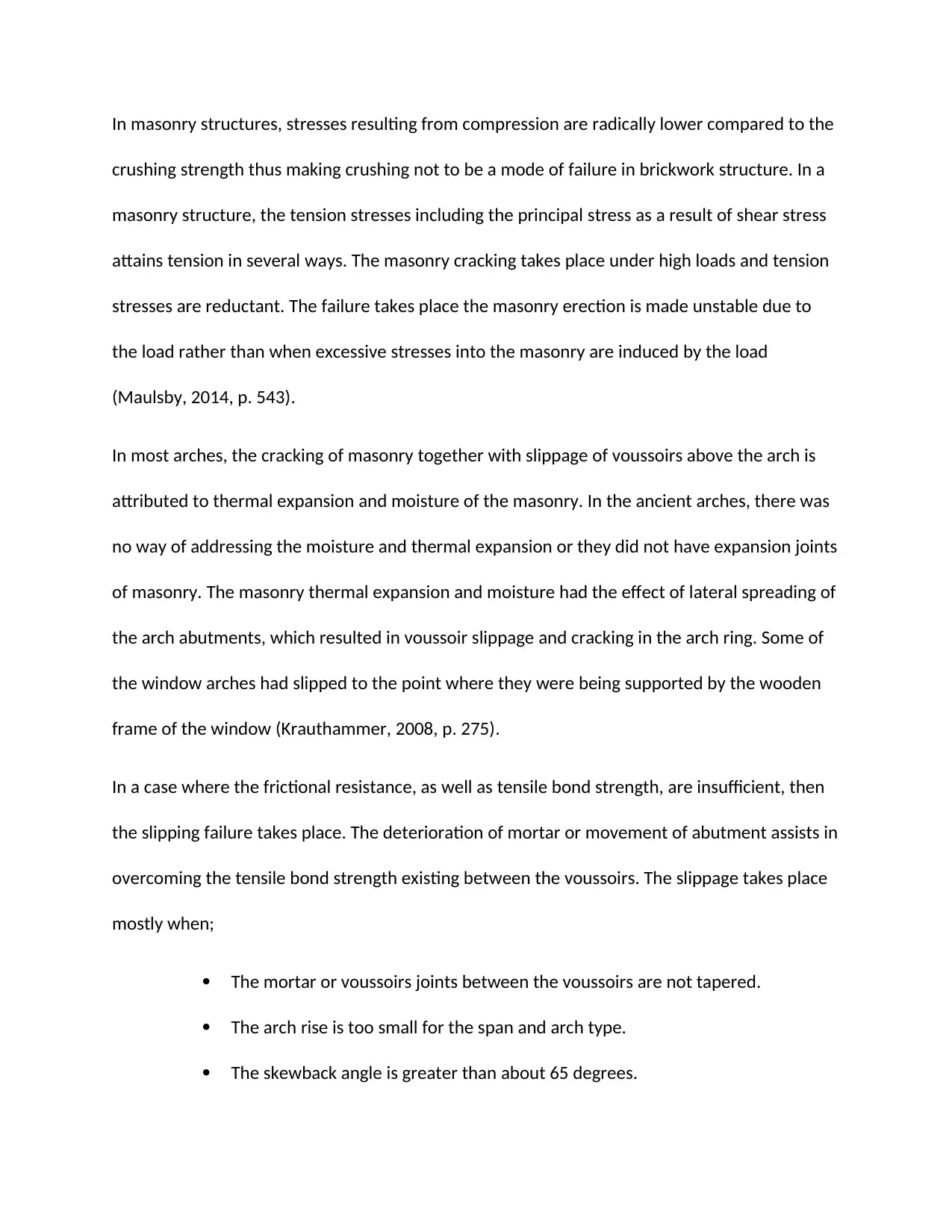
In masonry structures, stresses resulting from compression are radically lower compared to the
crushing strength thus making crushing not to be a mode of failure in brickwork structure. In a
masonry structure, the tension stresses including the principal stress as a result of shear stress
attains tension in several ways. The masonry cracking takes place under high loads and tension
stresses are reductant. The failure takes place the masonry erection is made unstable due to
the load rather than when excessive stresses into the masonry are induced by the load
(Maulsby, 2014, p. 543).
In most arches, the cracking of masonry together with slippage of voussoirs above the arch is
attributed to thermal expansion and moisture of the masonry. In the ancient arches, there was
no way of addressing the moisture and thermal expansion or they did not have expansion joints
of masonry. The masonry thermal expansion and moisture had the effect of lateral spreading of
the arch abutments, which resulted in voussoir slippage and cracking in the arch ring. Some of
the window arches had slipped to the point where they were being supported by the wooden
frame of the window (Krauthammer, 2008, p. 275).
In a case where the frictional resistance, as well as tensile bond strength, are insufficient, then
the slipping failure takes place. The deterioration of mortar or movement of abutment assists in
overcoming the tensile bond strength existing between the voussoirs. The slippage takes place
mostly when;
The mortar or voussoirs joints between the voussoirs are not tapered.
The arch rise is too small for the span and arch type.
The skewback angle is greater than about 65 degrees.
crushing strength thus making crushing not to be a mode of failure in brickwork structure. In a
masonry structure, the tension stresses including the principal stress as a result of shear stress
attains tension in several ways. The masonry cracking takes place under high loads and tension
stresses are reductant. The failure takes place the masonry erection is made unstable due to
the load rather than when excessive stresses into the masonry are induced by the load
(Maulsby, 2014, p. 543).
In most arches, the cracking of masonry together with slippage of voussoirs above the arch is
attributed to thermal expansion and moisture of the masonry. In the ancient arches, there was
no way of addressing the moisture and thermal expansion or they did not have expansion joints
of masonry. The masonry thermal expansion and moisture had the effect of lateral spreading of
the arch abutments, which resulted in voussoir slippage and cracking in the arch ring. Some of
the window arches had slipped to the point where they were being supported by the wooden
frame of the window (Krauthammer, 2008, p. 275).
In a case where the frictional resistance, as well as tensile bond strength, are insufficient, then
the slipping failure takes place. The deterioration of mortar or movement of abutment assists in
overcoming the tensile bond strength existing between the voussoirs. The slippage takes place
mostly when;
The mortar or voussoirs joints between the voussoirs are not tapered.
The arch rise is too small for the span and arch type.
The skewback angle is greater than about 65 degrees.
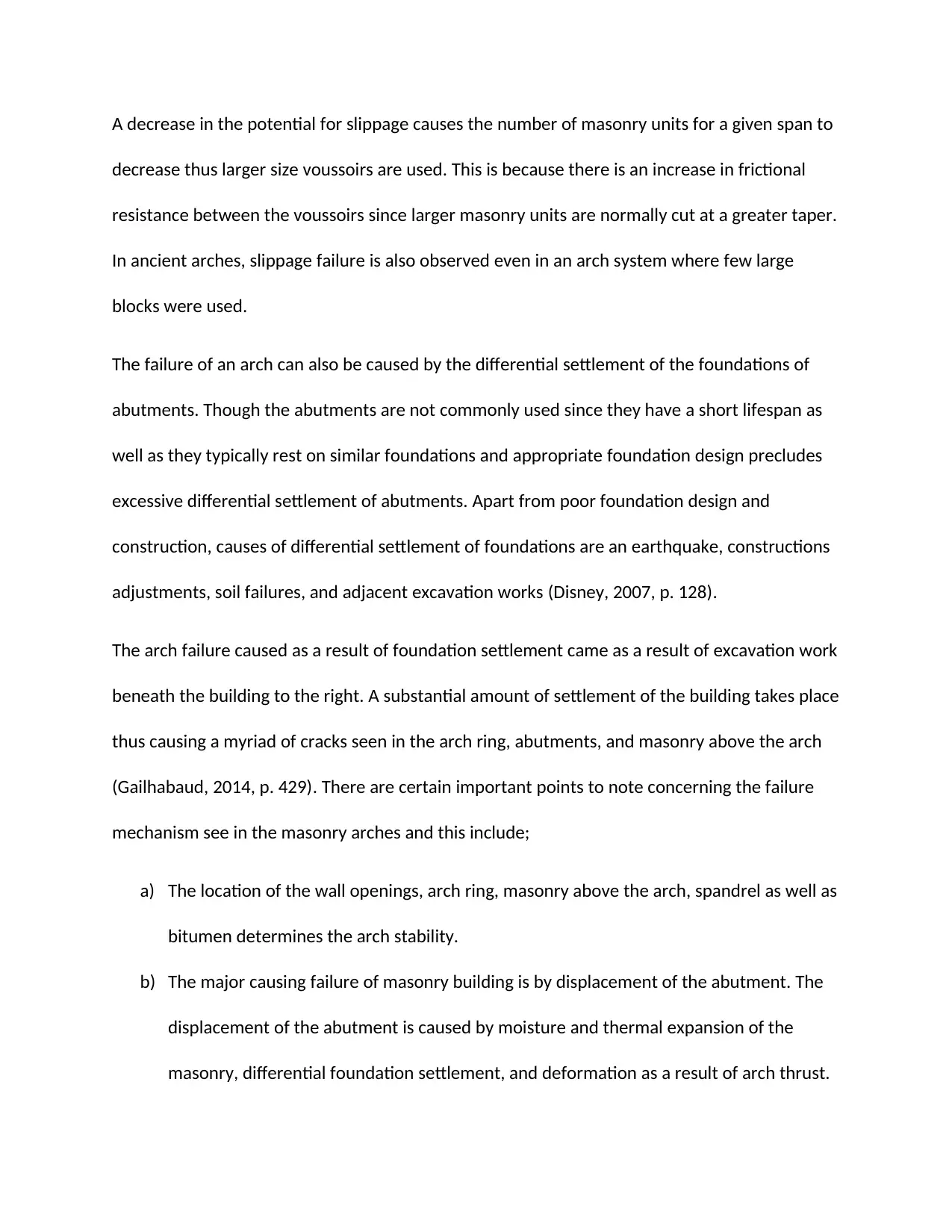
A decrease in the potential for slippage causes the number of masonry units for a given span to
decrease thus larger size voussoirs are used. This is because there is an increase in frictional
resistance between the voussoirs since larger masonry units are normally cut at a greater taper.
In ancient arches, slippage failure is also observed even in an arch system where few large
blocks were used.
The failure of an arch can also be caused by the differential settlement of the foundations of
abutments. Though the abutments are not commonly used since they have a short lifespan as
well as they typically rest on similar foundations and appropriate foundation design precludes
excessive differential settlement of abutments. Apart from poor foundation design and
construction, causes of differential settlement of foundations are an earthquake, constructions
adjustments, soil failures, and adjacent excavation works (Disney, 2007, p. 128).
The arch failure caused as a result of foundation settlement came as a result of excavation work
beneath the building to the right. A substantial amount of settlement of the building takes place
thus causing a myriad of cracks seen in the arch ring, abutments, and masonry above the arch
(Gailhabaud, 2014, p. 429). There are certain important points to note concerning the failure
mechanism see in the masonry arches and this include;
a) The location of the wall openings, arch ring, masonry above the arch, spandrel as well as
bitumen determines the arch stability.
b) The major causing failure of masonry building is by displacement of the abutment. The
displacement of the abutment is caused by moisture and thermal expansion of the
masonry, differential foundation settlement, and deformation as a result of arch thrust.
decrease thus larger size voussoirs are used. This is because there is an increase in frictional
resistance between the voussoirs since larger masonry units are normally cut at a greater taper.
In ancient arches, slippage failure is also observed even in an arch system where few large
blocks were used.
The failure of an arch can also be caused by the differential settlement of the foundations of
abutments. Though the abutments are not commonly used since they have a short lifespan as
well as they typically rest on similar foundations and appropriate foundation design precludes
excessive differential settlement of abutments. Apart from poor foundation design and
construction, causes of differential settlement of foundations are an earthquake, constructions
adjustments, soil failures, and adjacent excavation works (Disney, 2007, p. 128).
The arch failure caused as a result of foundation settlement came as a result of excavation work
beneath the building to the right. A substantial amount of settlement of the building takes place
thus causing a myriad of cracks seen in the arch ring, abutments, and masonry above the arch
(Gailhabaud, 2014, p. 429). There are certain important points to note concerning the failure
mechanism see in the masonry arches and this include;
a) The location of the wall openings, arch ring, masonry above the arch, spandrel as well as
bitumen determines the arch stability.
b) The major causing failure of masonry building is by displacement of the abutment. The
displacement of the abutment is caused by moisture and thermal expansion of the
masonry, differential foundation settlement, and deformation as a result of arch thrust.
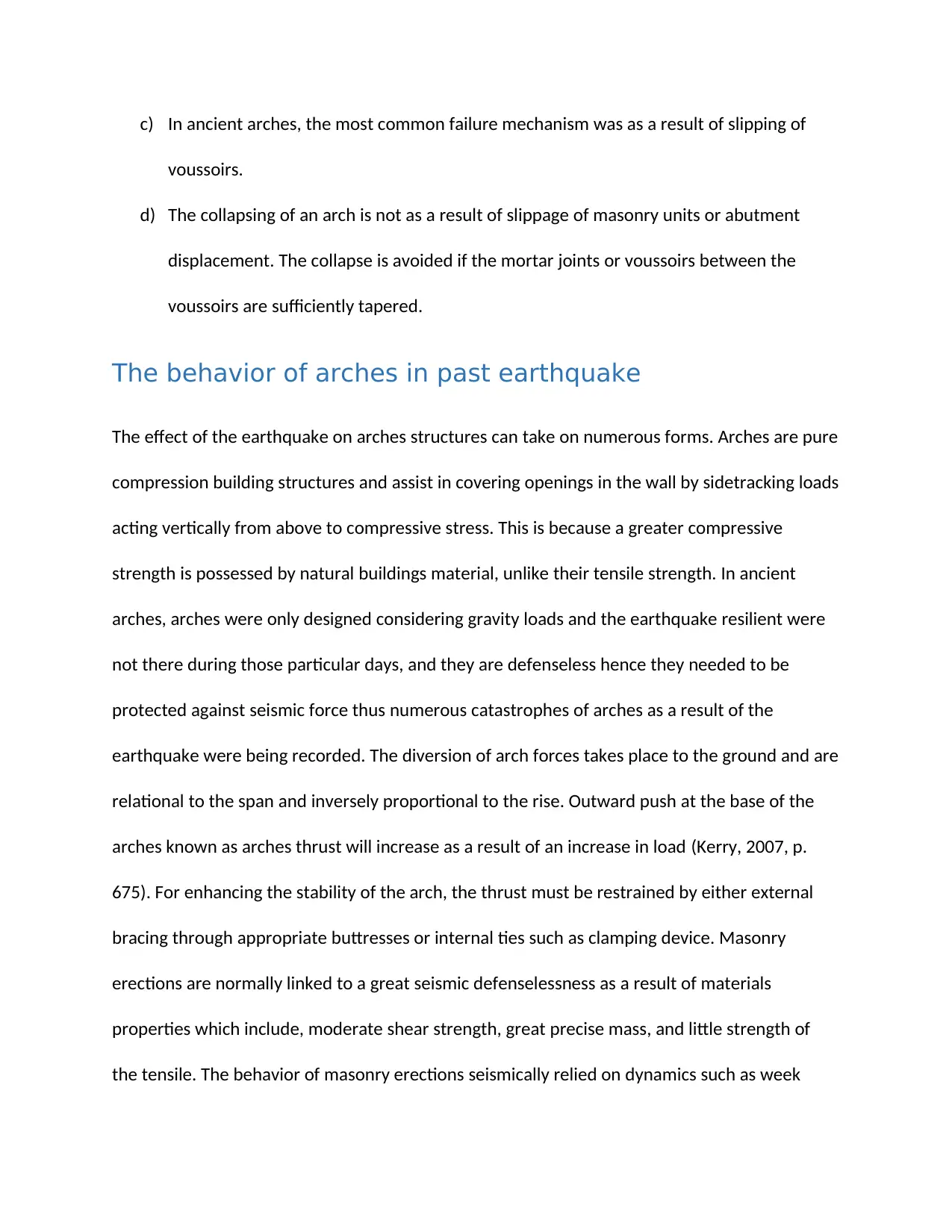
c) In ancient arches, the most common failure mechanism was as a result of slipping of
voussoirs.
d) The collapsing of an arch is not as a result of slippage of masonry units or abutment
displacement. The collapse is avoided if the mortar joints or voussoirs between the
voussoirs are sufficiently tapered.
The behavior of arches in past earthquake
The effect of the earthquake on arches structures can take on numerous forms. Arches are pure
compression building structures and assist in covering openings in the wall by sidetracking loads
acting vertically from above to compressive stress. This is because a greater compressive
strength is possessed by natural buildings material, unlike their tensile strength. In ancient
arches, arches were only designed considering gravity loads and the earthquake resilient were
not there during those particular days, and they are defenseless hence they needed to be
protected against seismic force thus numerous catastrophes of arches as a result of the
earthquake were being recorded. The diversion of arch forces takes place to the ground and are
relational to the span and inversely proportional to the rise. Outward push at the base of the
arches known as arches thrust will increase as a result of an increase in load (Kerry, 2007, p.
675). For enhancing the stability of the arch, the thrust must be restrained by either external
bracing through appropriate buttresses or internal ties such as clamping device. Masonry
erections are normally linked to a great seismic defenselessness as a result of materials
properties which include, moderate shear strength, great precise mass, and little strength of
the tensile. The behavior of masonry erections seismically relied on dynamics such as week
voussoirs.
d) The collapsing of an arch is not as a result of slippage of masonry units or abutment
displacement. The collapse is avoided if the mortar joints or voussoirs between the
voussoirs are sufficiently tapered.
The behavior of arches in past earthquake
The effect of the earthquake on arches structures can take on numerous forms. Arches are pure
compression building structures and assist in covering openings in the wall by sidetracking loads
acting vertically from above to compressive stress. This is because a greater compressive
strength is possessed by natural buildings material, unlike their tensile strength. In ancient
arches, arches were only designed considering gravity loads and the earthquake resilient were
not there during those particular days, and they are defenseless hence they needed to be
protected against seismic force thus numerous catastrophes of arches as a result of the
earthquake were being recorded. The diversion of arch forces takes place to the ground and are
relational to the span and inversely proportional to the rise. Outward push at the base of the
arches known as arches thrust will increase as a result of an increase in load (Kerry, 2007, p.
675). For enhancing the stability of the arch, the thrust must be restrained by either external
bracing through appropriate buttresses or internal ties such as clamping device. Masonry
erections are normally linked to a great seismic defenselessness as a result of materials
properties which include, moderate shear strength, great precise mass, and little strength of
the tensile. The behavior of masonry erections seismically relied on dynamics such as week
Paraphrase This Document
Need a fresh take? Get an instant paraphrase of this document with our AI Paraphraser
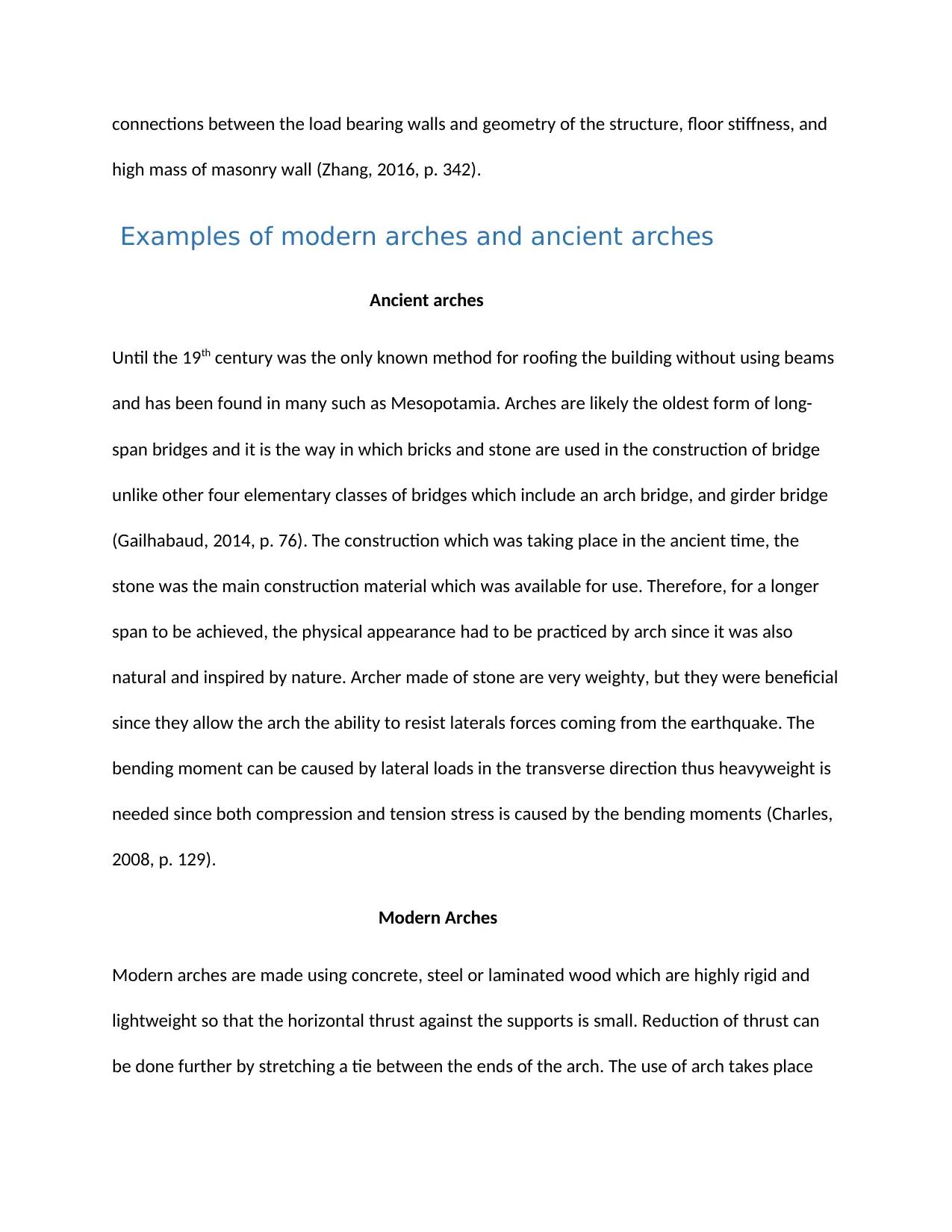
connections between the load bearing walls and geometry of the structure, floor stiffness, and
high mass of masonry wall (Zhang, 2016, p. 342).
Examples of modern arches and ancient arches
Ancient arches
Until the 19th century was the only known method for roofing the building without using beams
and has been found in many such as Mesopotamia. Arches are likely the oldest form of long-
span bridges and it is the way in which bricks and stone are used in the construction of bridge
unlike other four elementary classes of bridges which include an arch bridge, and girder bridge
(Gailhabaud, 2014, p. 76). The construction which was taking place in the ancient time, the
stone was the main construction material which was available for use. Therefore, for a longer
span to be achieved, the physical appearance had to be practiced by arch since it was also
natural and inspired by nature. Archer made of stone are very weighty, but they were beneficial
since they allow the arch the ability to resist laterals forces coming from the earthquake. The
bending moment can be caused by lateral loads in the transverse direction thus heavyweight is
needed since both compression and tension stress is caused by the bending moments (Charles,
2008, p. 129).
Modern Arches
Modern arches are made using concrete, steel or laminated wood which are highly rigid and
lightweight so that the horizontal thrust against the supports is small. Reduction of thrust can
be done further by stretching a tie between the ends of the arch. The use of arch takes place
high mass of masonry wall (Zhang, 2016, p. 342).
Examples of modern arches and ancient arches
Ancient arches
Until the 19th century was the only known method for roofing the building without using beams
and has been found in many such as Mesopotamia. Arches are likely the oldest form of long-
span bridges and it is the way in which bricks and stone are used in the construction of bridge
unlike other four elementary classes of bridges which include an arch bridge, and girder bridge
(Gailhabaud, 2014, p. 76). The construction which was taking place in the ancient time, the
stone was the main construction material which was available for use. Therefore, for a longer
span to be achieved, the physical appearance had to be practiced by arch since it was also
natural and inspired by nature. Archer made of stone are very weighty, but they were beneficial
since they allow the arch the ability to resist laterals forces coming from the earthquake. The
bending moment can be caused by lateral loads in the transverse direction thus heavyweight is
needed since both compression and tension stress is caused by the bending moments (Charles,
2008, p. 129).
Modern Arches
Modern arches are made using concrete, steel or laminated wood which are highly rigid and
lightweight so that the horizontal thrust against the supports is small. Reduction of thrust can
be done further by stretching a tie between the ends of the arch. The use of arch takes place
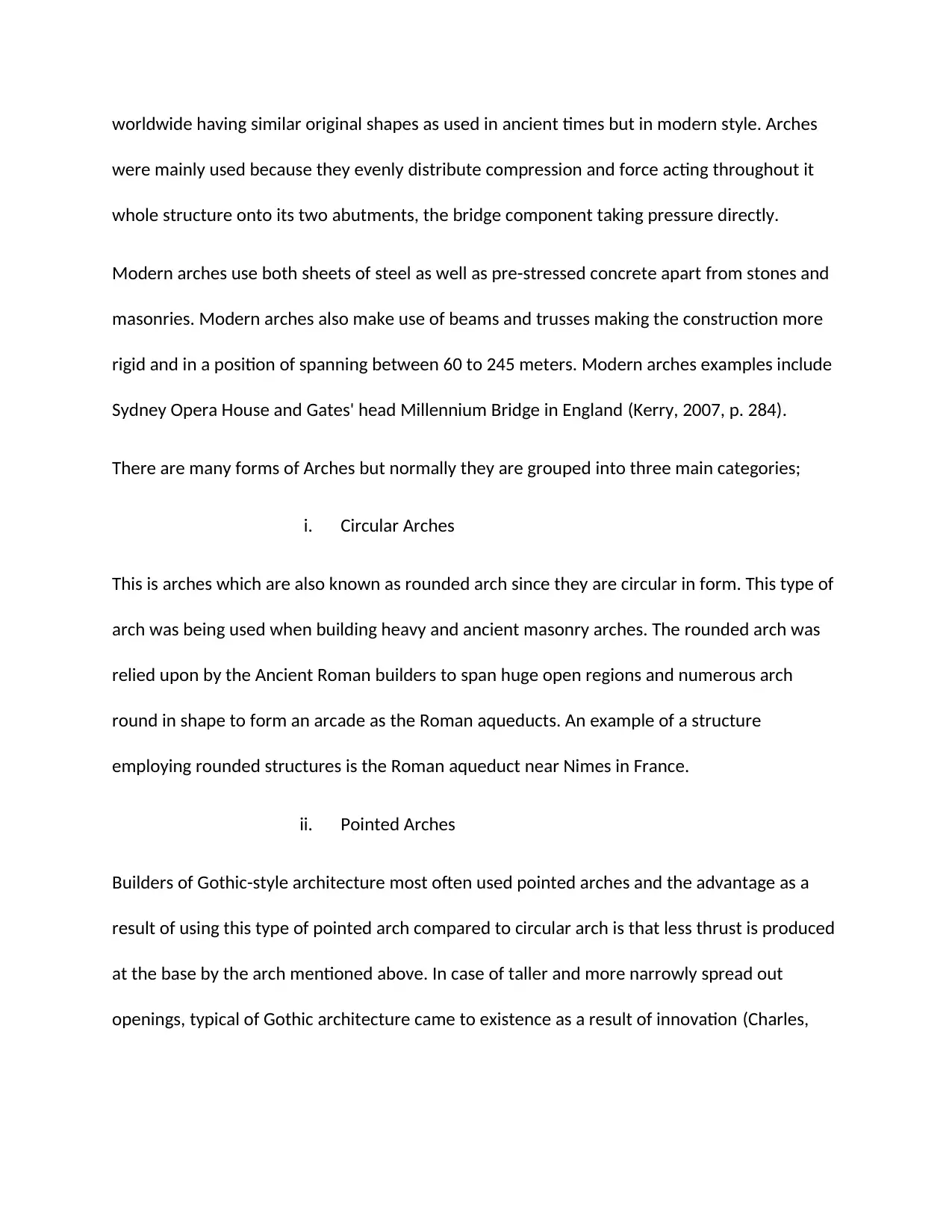
worldwide having similar original shapes as used in ancient times but in modern style. Arches
were mainly used because they evenly distribute compression and force acting throughout it
whole structure onto its two abutments, the bridge component taking pressure directly.
Modern arches use both sheets of steel as well as pre-stressed concrete apart from stones and
masonries. Modern arches also make use of beams and trusses making the construction more
rigid and in a position of spanning between 60 to 245 meters. Modern arches examples include
Sydney Opera House and Gates' head Millennium Bridge in England (Kerry, 2007, p. 284).
There are many forms of Arches but normally they are grouped into three main categories;
i. Circular Arches
This is arches which are also known as rounded arch since they are circular in form. This type of
arch was being used when building heavy and ancient masonry arches. The rounded arch was
relied upon by the Ancient Roman builders to span huge open regions and numerous arch
round in shape to form an arcade as the Roman aqueducts. An example of a structure
employing rounded structures is the Roman aqueduct near Nimes in France.
ii. Pointed Arches
Builders of Gothic-style architecture most often used pointed arches and the advantage as a
result of using this type of pointed arch compared to circular arch is that less thrust is produced
at the base by the arch mentioned above. In case of taller and more narrowly spread out
openings, typical of Gothic architecture came to existence as a result of innovation (Charles,
were mainly used because they evenly distribute compression and force acting throughout it
whole structure onto its two abutments, the bridge component taking pressure directly.
Modern arches use both sheets of steel as well as pre-stressed concrete apart from stones and
masonries. Modern arches also make use of beams and trusses making the construction more
rigid and in a position of spanning between 60 to 245 meters. Modern arches examples include
Sydney Opera House and Gates' head Millennium Bridge in England (Kerry, 2007, p. 284).
There are many forms of Arches but normally they are grouped into three main categories;
i. Circular Arches
This is arches which are also known as rounded arch since they are circular in form. This type of
arch was being used when building heavy and ancient masonry arches. The rounded arch was
relied upon by the Ancient Roman builders to span huge open regions and numerous arch
round in shape to form an arcade as the Roman aqueducts. An example of a structure
employing rounded structures is the Roman aqueduct near Nimes in France.
ii. Pointed Arches
Builders of Gothic-style architecture most often used pointed arches and the advantage as a
result of using this type of pointed arch compared to circular arch is that less thrust is produced
at the base by the arch mentioned above. In case of taller and more narrowly spread out
openings, typical of Gothic architecture came to existence as a result of innovation (Charles,
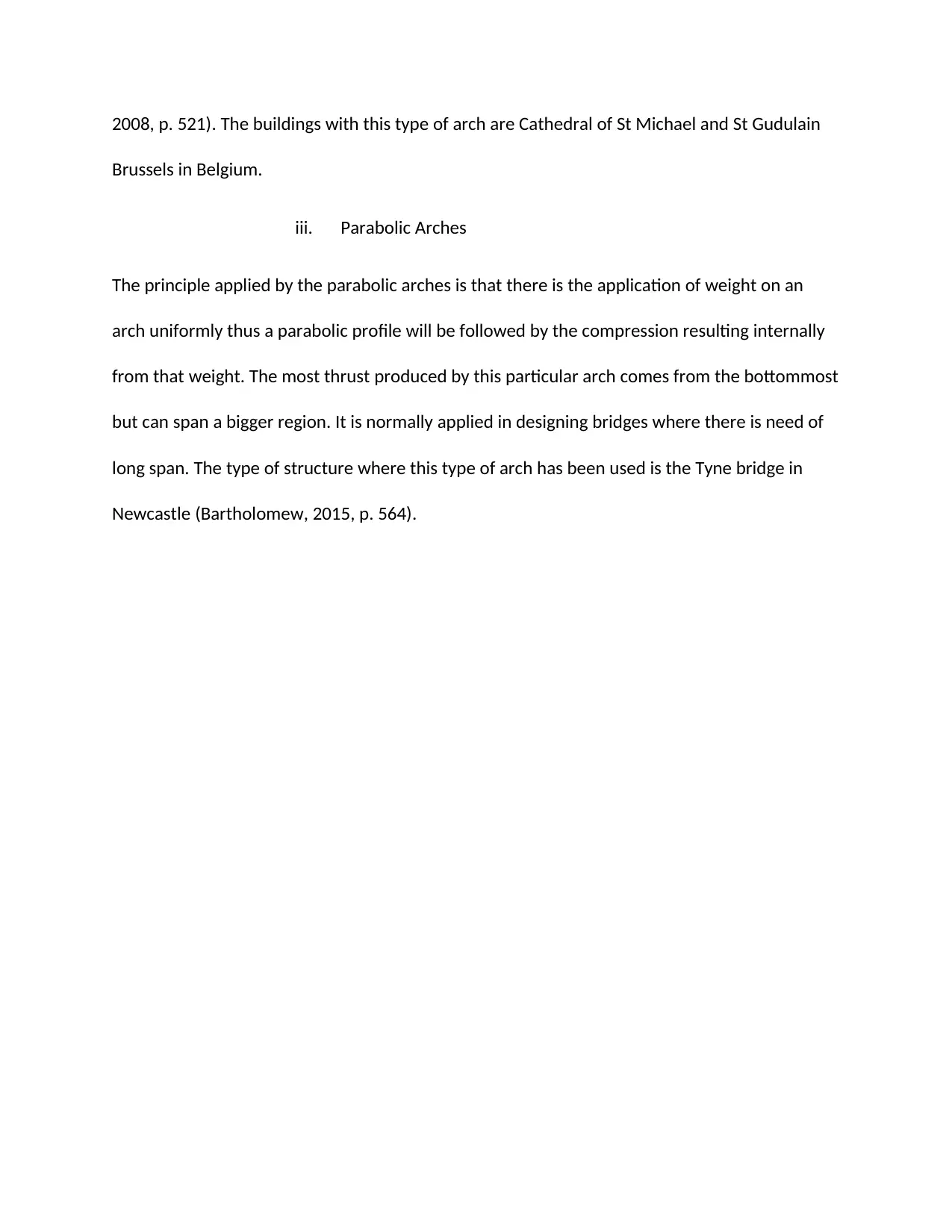
2008, p. 521). The buildings with this type of arch are Cathedral of St Michael and St Gudulain
Brussels in Belgium.
iii. Parabolic Arches
The principle applied by the parabolic arches is that there is the application of weight on an
arch uniformly thus a parabolic profile will be followed by the compression resulting internally
from that weight. The most thrust produced by this particular arch comes from the bottommost
but can span a bigger region. It is normally applied in designing bridges where there is need of
long span. The type of structure where this type of arch has been used is the Tyne bridge in
Newcastle (Bartholomew, 2015, p. 564).
Brussels in Belgium.
iii. Parabolic Arches
The principle applied by the parabolic arches is that there is the application of weight on an
arch uniformly thus a parabolic profile will be followed by the compression resulting internally
from that weight. The most thrust produced by this particular arch comes from the bottommost
but can span a bigger region. It is normally applied in designing bridges where there is need of
long span. The type of structure where this type of arch has been used is the Tyne bridge in
Newcastle (Bartholomew, 2015, p. 564).
Secure Best Marks with AI Grader
Need help grading? Try our AI Grader for instant feedback on your assignments.
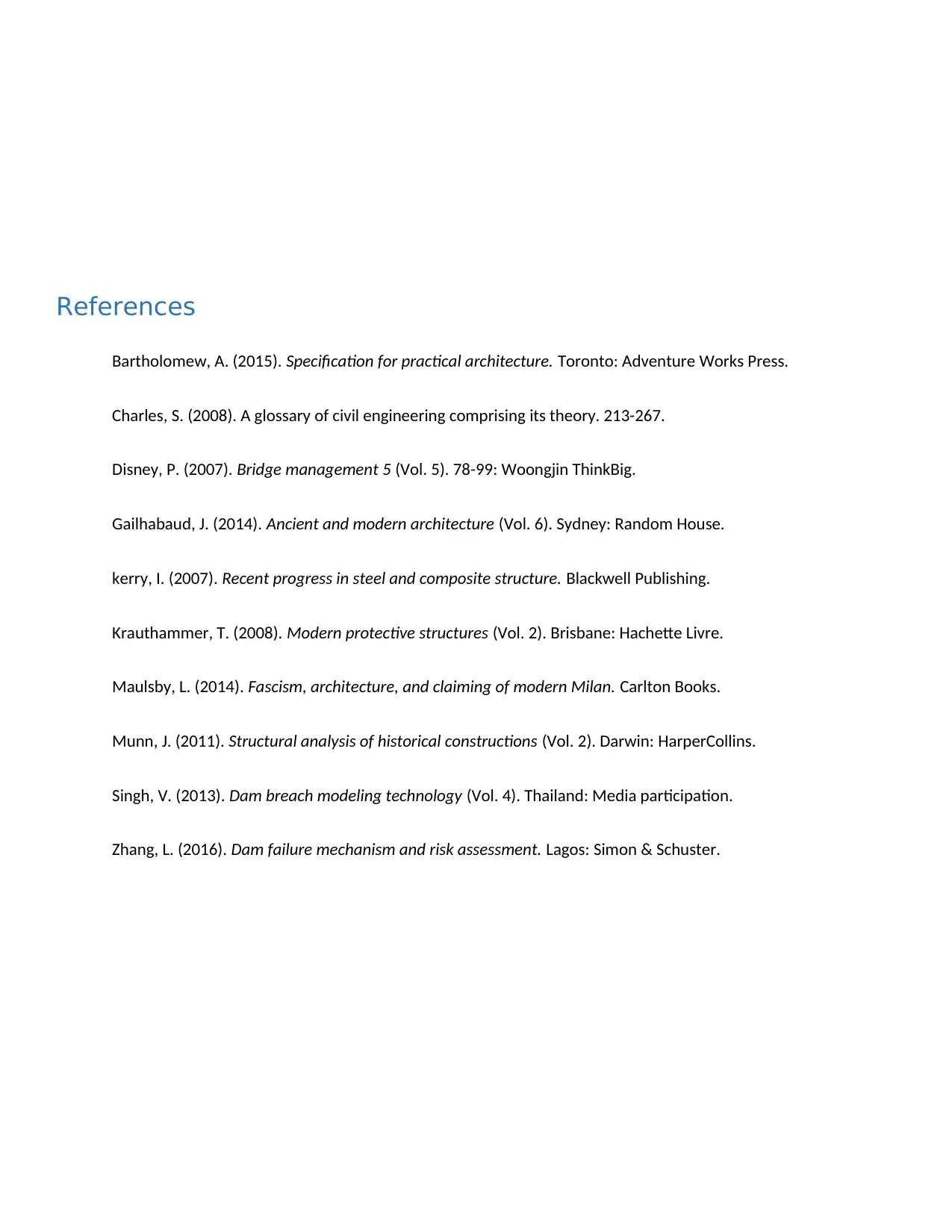
References
Bartholomew, A. (2015). Specification for practical architecture. Toronto: Adventure Works Press.
Charles, S. (2008). A glossary of civil engineering comprising its theory. 213-267.
Disney, P. (2007). Bridge management 5 (Vol. 5). 78-99: Woongjin ThinkBig.
Gailhabaud, J. (2014). Ancient and modern architecture (Vol. 6). Sydney: Random House.
kerry, I. (2007). Recent progress in steel and composite structure. Blackwell Publishing.
Krauthammer, T. (2008). Modern protective structures (Vol. 2). Brisbane: Hachette Livre.
Maulsby, L. (2014). Fascism, architecture, and claiming of modern Milan. Carlton Books.
Munn, J. (2011). Structural analysis of historical constructions (Vol. 2). Darwin: HarperCollins.
Singh, V. (2013). Dam breach modeling technology (Vol. 4). Thailand: Media participation.
Zhang, L. (2016). Dam failure mechanism and risk assessment. Lagos: Simon & Schuster.
Bartholomew, A. (2015). Specification for practical architecture. Toronto: Adventure Works Press.
Charles, S. (2008). A glossary of civil engineering comprising its theory. 213-267.
Disney, P. (2007). Bridge management 5 (Vol. 5). 78-99: Woongjin ThinkBig.
Gailhabaud, J. (2014). Ancient and modern architecture (Vol. 6). Sydney: Random House.
kerry, I. (2007). Recent progress in steel and composite structure. Blackwell Publishing.
Krauthammer, T. (2008). Modern protective structures (Vol. 2). Brisbane: Hachette Livre.
Maulsby, L. (2014). Fascism, architecture, and claiming of modern Milan. Carlton Books.
Munn, J. (2011). Structural analysis of historical constructions (Vol. 2). Darwin: HarperCollins.
Singh, V. (2013). Dam breach modeling technology (Vol. 4). Thailand: Media participation.
Zhang, L. (2016). Dam failure mechanism and risk assessment. Lagos: Simon & Schuster.
1 out of 11
Related Documents
Your All-in-One AI-Powered Toolkit for Academic Success.
+13062052269
info@desklib.com
Available 24*7 on WhatsApp / Email
![[object Object]](/_next/static/media/star-bottom.7253800d.svg)
Unlock your academic potential
© 2024 | Zucol Services PVT LTD | All rights reserved.




